Presence of pathogens and acute stressors plays a critical role in determining outcomes
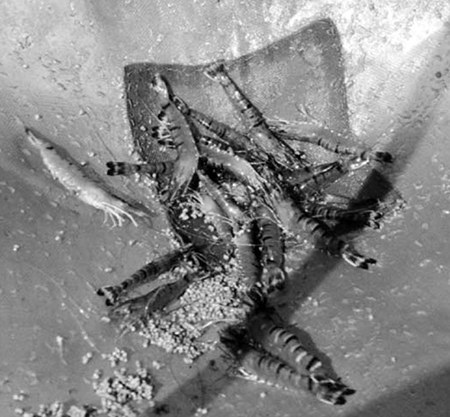
There is little argument that disease prevention (proactive management) is preferable to disease treatment (reactive management). However, prevention can be costlier in the short term, and if it works and problems do not appear, continued preventive expenditures are less likely to occur. There are many approaches taken towards the proactive management of diseases in shrimp farming. These include use of diagnostics, chemotherapeutants, probotics, vaccines, stress management, nutrition, pathogen avoidance, genetics, and non-traditional approaches. This article focuses on the use of commonly accepted, non-specific immune stimulants.
Shrimp have a powerful ability to respond non-specifically to a variety of compounds, most of which are apparently carbohydrate-based. Exploration of this area is just beginning, but there is hope that this can result in disease prevention or mitigation (7). There are, literally, dozens of substances that have been found to exert a non-specific influence on the immune system of animals, and probably a half a dozen compounds have been looked at in shrimp. Three substances that are structural components of bacteria and yeast have been the subjects of close scrutiny: beta 1-3 glucans, lipopolysaccharides and peptidoglycans.
Beta 1-3 glucans
These are polymers of glucose molecules linked by a specific type of chemical bond (beta 1-3). They are components of the cell walls of fungi, yeast, and some algae and bacteria. Though they are being sold in many different forms, most of the commercially available forms are derived from the common yeast Saccharomyces cerevisiae. They are essentially yeast extracts with varying degrees of purity. There is no correlation between the degree of reported purity and their efficacy.
There have been some well-conducted laboratory studies that show that some glucans (but not all) exert a short-term effect on the immune system of shrimp, and can provide non-specific protection against bacterial and viral diseases (8,9). However, there are several drawbacks to their use, notably the fact that many crustaceans digest them, as they are a natural component of their food in the wild (10, 11). They also differ substantially as to effectiveness (7).
Finally the heat of milling feed breaks them down (9). These shortcomings quite likely contribute to the high degree of variability noted when they are used in the feed. Like all other compounds of this nature, those that exert a true impact on the immune system can result in immune suppression if not used properly. It is important that all of these factors are considered when using glucans on a continuous basis. Data suggest that they may work better when used in conjunction with other substances (7,12).
Lipopolysaccharides
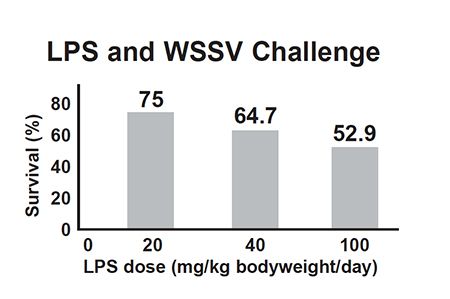 These are a structural component of the cell walls of a specific type of bacteria (gram negative), though they can also be found in algae and other types of bacteria as well. Vibrios, the most common bacterial pathogens affecting shrimp, present these structural components to the immune system of the animal. Lipopolysaccharides (LPS) have been extensively tested in the lab and the field, and have potent nonspecific antiviral and antibacterial effects. Although they are toxic to mammals, they are not toxic to fish or shrimp, as neither possesses a histamine- mediated inflammatory response.
These are a structural component of the cell walls of a specific type of bacteria (gram negative), though they can also be found in algae and other types of bacteria as well. Vibrios, the most common bacterial pathogens affecting shrimp, present these structural components to the immune system of the animal. Lipopolysaccharides (LPS) have been extensively tested in the lab and the field, and have potent nonspecific antiviral and antibacterial effects. Although they are toxic to mammals, they are not toxic to fish or shrimp, as neither possesses a histamine- mediated inflammatory response.
Laboratory trials have shown that shrimp exposed to LPS preparations are better able to tolerate exposure to a number of viruses including TSV and WSSV, as well as bacteria (Vibrio species) (7, 13). Field trials have shown a variety of effects, ranging from increased survival to improved feed conversions and growth (7). One recent laboratory study (13) showed that animals that were fed varying levels of an LPS preparation (20, 40 or 100 milligrams per kilogram body weight per day) and exposed to WSSV after being fed for 18 days were able to resist infection. They were challenged by a continuous water-borne exposure.
Peptidoglycans
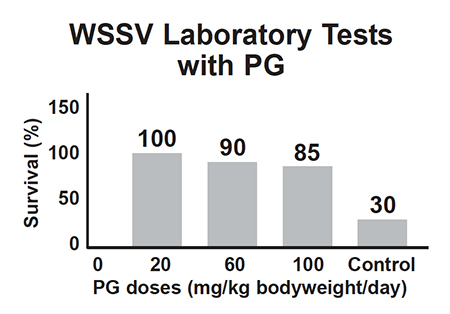 These are components of the cell walls of many different bacteria, and have been found to enhance non-specific immunity and increase the tolerance to stress in shrimp (7). Recent reports have documented that peptidoglycans (PG) can increase the ability of shrimp to tolerate exposure to WSSV.
These are components of the cell walls of many different bacteria, and have been found to enhance non-specific immunity and increase the tolerance to stress in shrimp (7). Recent reports have documented that peptidoglycans (PG) can increase the ability of shrimp to tolerate exposure to WSSV.
In an experiment similar to the one described above in which an LPS compound was evaluated, shrimp fed with varying levels (20, 60 and 100 milligrams per kilogram body weight per day) of PG were able to resist a continuous water borne exposure to the WSSV virus.
Others
Recent reports have shown that an extract from certain algae has potent anti-viral activity. The material, known as fucoidan, has been characterized and belongs to a class of sulfate-containing polysaccharides. Fucoidan has been shown to have anti-enveloped virus activity. Laboratory studies have shown a benefit (14) and preliminary field data suggests that there may also be a benefit under some circumstances. In laboratory trials, substantial protection was observed when shrimp were fed 60 or 100 milligrams per kilogram body weight per day prior to exposure to the virus.
Conclusions
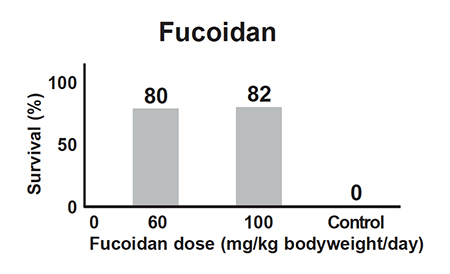 It is important to recognize that shrimp farming is a complex process with many interacting variables. It is likely that in the case of diseases such as that due to the WSSV, the presence of other pathogens and acute stressors can play a critical role in the outcome of the disease process.
It is important to recognize that shrimp farming is a complex process with many interacting variables. It is likely that in the case of diseases such as that due to the WSSV, the presence of other pathogens and acute stressors can play a critical role in the outcome of the disease process.
In the face of repeated disease outbreaks, long-term success and sustainability in shrimp farming can only be achieved by the use of appropriate husbandry strategies. No single approach can result in success all of the time. For this reason, a variety of strategies need to be considered when looking at proactively managing any potential pathogen.
Focusing on a few and ignoring others, while creating the illusion of control, may ultimately result in failure. This article was extracted from a larger paper, which can be found at http://www.shrimpaquaculture.com. Numbers in parentheses refer to literature citations in the larger paper.
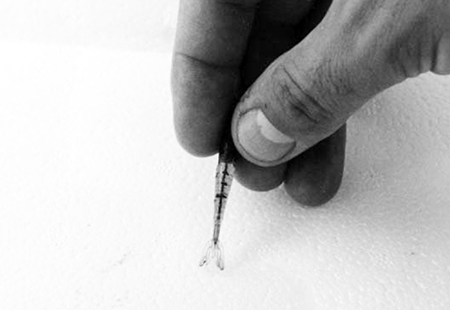
(Editor’s Note: This article was originally published in the February 2000 print edition of the Global Aquaculture Advocate.)
Now that you've finished reading the article ...
… we hope you’ll consider supporting our mission to document the evolution of the global aquaculture industry and share our vast network of contributors’ expansive knowledge every week.
By becoming a Global Seafood Alliance member, you’re ensuring that all of the pre-competitive work we do through member benefits, resources and events can continue. Individual membership costs just $50 a year. GSA individual and corporate members receive complimentary access to a series of GOAL virtual events beginning in April. Join now.
Not a GSA member? Join us.
Author
-
Stephen G. Newman, Ph.D.
President and CEO
Aqua-In-Tech Inc.
6722 162nd Place SW
Lynnwood, WA 98037 USA
Tagged With
Related Posts

Health & Welfare
Effect of a commercial parabiotic on shrimp production
This article presents lab and field test results for a proprietary parabiotic on Pacific white shrimp farms in Latin America and Southeast Asia.

Health & Welfare
Working with fish, limiting zoonotic diseases
Prevention through good hygiene, use of gloves and basic biosecurity procedures is the best method for reducing the risk of acquiring zoonotic diseases.

Health & Welfare
A holistic management approach to EMS
Early Mortality Syndrome has devastated farmed shrimp in Asia and Latin America. With better understanding of the pathogen and the development and improvement of novel strategies, shrimp farmers are now able to better manage the disease.

Health & Welfare
Impacts of acute hepatopancreatic necrosis syndrome
Research continues in the global efforts to identify the cause of acute hepatopancreatic necrosis syndrome in farmed shrimp and find solutions to stop the major losses caused by its spread.


